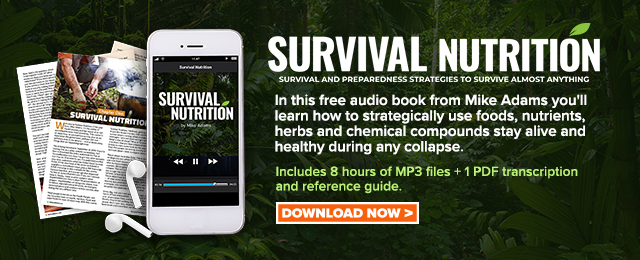
Biointensive agriculture could save the planet
Friday, March 18, 2011 by: Cindy Jones-Shoeman
Tags: biointensive agriculture, food production, health news
- Newly released JFK files reveal Pentagon's role in creating Lyme disease and covid in the same lab
- The hidden dangers in your kitchen: How cooking methods impact diabetes, cancer and aging
- DEADLY DECEPTION: How COVID vaccines increased mortality rates and why authorities hid the truth
- CDC finally halts $11 billion COVID funding scam as health officials admit the ‘pandemic’ was a fraud
- Arkansas embraces medical freedom with landmark ivermectin law
- GAIN-OF-FUNCTION CAT-BIRD-FLU now on the rise as nearly a dozen cats in Colorado "test positive" for Bird Flu due to contaminated cat food
- Lab leak confirmed? Boris Johnson's stunning reversal on COVID origins sparks global debate
- Home gardening for preppers: A beginner's guide to growing your own food
- Trump's greatest betrayal so far: Accelerating Middle East wars, silencing dissent, and serving Zionist masters
- Cartels shift tactics: Kidnappings and organ trafficking surge as border crossings plummet under Trump policies
- Why you should think twice before buying mainstream toothpaste formulas
- Was JFK's assassination orchestrated by a CIA double agent? New evidence points to James Angleton as the “architect”
- ATTENTION PRESIDENT TRUMP: Please WITHDRAW your nomination of Dr. Susan Monarez for CDC Director as she is a VAX FANATIC and TOXIC JAB ZEALOT
- Key nodes of Federal Government censorship
- Record honeybee deaths devastate U.S. agriculture, pesticides under scrutiny
- Speaker Johnson warns Congress may defund or disband rogue courts targeting Trump
- Paper or plastic? The environmental deception behind bag bans
- Here are TEN all-natural ways to protect your garden without using harmful chemicals
- Newly released JFK files reveal Pentagon's role in creating Lyme disease and covid in the same lab
- Elon Musk: Aliens could be here on Earth RIGHT NOW
- Festive flavors: The sweet history, nutritional profile and health benefits of pecan pie
- Trump reverses course on Gaza plan, says “nobody is expelling Palestinians”
- Reclaim your health: How midlife exercise reverses years of inactivity
- Big Pharma's $8 Billion bribery scheme exposed: how doctors are pushed to prescribe junk science, not heal
- Boys are back in town: Trump’s patriotic alpha crew takes the wheel while toxic females ride in the backseat
- EPA advisor admits the agency is funneling billions to climate groups ahead of Trump’s return to White House
- Space war brewing? Russia threatens to destroy Starlink satellites
- Survival 101: Effective EMF blocking techniques
- A lack of integrity in Academia: Harvard professor found GUILTY of fraudulent research to promote CRT theory
- Mike Adams Sermon 66: God will DESTROY ISRAEL for its wickedness
- 5 Simple steps to boost your brainpower: How to strengthen executive function in a distracted world
- Rep. Nancy Mace introduces bill to ban biological males from female facilities on federal property
- Sugarcane extract superior to cholesterol-lowering drugs?
- WHO focusing more on policing speech about public health and implementing global surveillance systems
- Pilots report mysterious lights 'moving at extreme speeds' across Oregon skies
- Dr. Mike Yeadon releases 15-minute testimony - WATCH - about genocidal intent of COVID “vaccines”
- EPA advisor admits the agency is funneling billions to climate groups ahead of Trump’s return to White House
- The Health Ranger releases “Vaccine Zombie” song and music video, using AI-animated zombies for the music video
- California's social media censorship law struck down: A victory for free speech or a threat to online safety?
- Dr. Mike Yeadon releases 15-minute testimony - WATCH - about genocidal intent of COVID “vaccines”
- The pandemic as a tool for INDOCTRINATION: Understanding “The Indoctrinated Brain” by Dr. Michael Nehls
- Florida takes a stand: DeSantis proposes permanent ban on mRNA vaccine mandates
- Mike Adams releases country western hit single: Goin’ Back in Time is Comin’ Home
- Mike Adams releases music poetry sensation: A Child of God
- “Why we influenced the 2020 elections”: Facebook files reveal the coordinated effort to bury the Hunter Biden laptop story
- RFK Jr. clears key hurdle: Sen. Susan Collins backs controversial HHS nominee, signaling a new era for health policy
- Unpacking the Lies That We’ve Been Fed – new song and music video released by Mike Adams, the Health Ranger
- Mike Adams releases new song and music video: Nothing More Disgusting Than a Globalist
- Newly released JFK files reveal Pentagon's role in creating Lyme disease and covid in the same lab
- Congratulations to the FULLY UNVACCINATED as you resisted the COVID-19 PROPAGANDA MACHINE fueled by over $100 BILLION
- Michigan sheriff announces criminal investigation into 2020 election crimes, Dominion Voting Systems
- Israeli soldiers accused of even more torture and abuse in the West Bank
- Migrants are taking advantage of recent hurricanes to scam residents and loot their homes
- House Intelligence Committee calls for the ARREST and PROSECUTION of Dr. Anthony Fauci
- Red Cross issues warning to stop blood plasma donations from vaccinated people
- Scientists confirm: GENIUS brain function can be spontaneously unleashed in humans without any apparent cause
- EPA advisor admits the agency is funneling billions to climate groups ahead of Trump’s return to White House
- HYSSOP: What research reveals about the health benefits of this ancient holy herb
- Two containers with completed ballots fall out of truck in Florida
- Fully vaccinated about to see “tsunami” of illness and death, warns virologist
- Global leaders unite to clamp down on “misinformation” with UN-backed Cascais Declaration
- BREAKING: 2025 NDAA authorizes mandatory military draft of WOMEN across America… as Pentagon pursues global NUCLEAR war with both Russia and China at the same time
- Michael Yon warns of a ZIONIST TAKEOVER in Trump’s second administration
- BOMBSHELL: DNA testing kits are a SCAM to develop ethnic-specific bioweapons
- Ozempic and Wegovy weight loss drugs are injectable LIZARD VENOM PEPTIDES that may unleash a devastating wave of organ failure… side effects align with symptoms of SNAKE BITES
- Israeli soldiers accused of even more torture and abuse in the West Bank
- These 13 countries just signed an agreement to engineer a global FAMINE by destroying food supply
- NASA admits that climate change occurs because of changes in Earth’s solar orbit, and NOT because of SUVs and fossil fuels
- RFK Jr. clears key hurdle: Sen. Susan Collins backs controversial HHS nominee, signaling a new era for health policy
- Sermon 30: How Jesus reveals Caesar’s FAKE CURRENCY and FALSE AUTHORITY
- Coriander seeds: Ancient medicine backed by modern science
- Arizona officials claim Maricopa County needs 10-13 days to tabulate results of the election
Many people turn to growing their own food and relying on themselves. That's one of the best things to do, but how does a person create a sustainable "farm"? Ecology Action has spent years refining its approach to sustainable agriculture, and the organization focuses on "mini-farms." Its techniques use less water and land but produce more food (in a sustainable environment) than most other techniques. There are eight principles that "Grow Biointensive" incorporates, and all these principles lead to a self-sustaining farming method.
- Prepare the soil. The biointensive gardening method advocates a particular method of soil preparation. It involves "double digging" the soil (loosening it to two feet deep), which aids in aeration and retention of water and allows roots to grow as deep as necessary. The beds are raised in a sloping fashion.
- Compost. Biointensive gardening requires composting, part of the reason why this method is sustainable.
- Plant "intensively." This method utilizes the space that the farmer has. Plants are grown closely together, so close that they almost touch, and they are not grown in typical row fashion.
- Utilize companion planting. Companion planting is a method whereby plants that grow well together are planted beside each other, creating an ecosystem of their own. For example, squash and corn are companion plants and grow well together. There are also plants that inhibit each other's growth and should, therefore, not be grown together. Finally, crops should be rotated on a regular basis every growing season.
- Employ carbon farming. Carbon farming helps with a farm's sustainability, as a large majority of the mini-farms' crops are grown for their carbon content (that will become compost). For example, corn, rye, and sunflowers are carbon plants.
- Utilize calorie farming. Calorie farming requires that the farmer use about one-third of his farming space to grow foods that will fuel the body (and give the most calories per bite). Examples of calorie crops are potatoes and garlic.
- Use open-pollinated seeds. A sustainable farm saves its own seeds, and if the seeds come from one's own farm, those seeds are from plants that have adapted to that particular growing environment.
- Rely on a "Whole System Farming Method." The biointensive approach requires that farmers commit to using all the principles of the method. If not all the principles are used, the method probably won't work. For example, only by carbon farming can the farmer generate enough materials for a healthy, usable compost. This compost will be used for the next year's garden. And if the farmer fails to follow the soil preparation techniques, the plants may not grow as expected. All of the techniques - used in a "whole system" approach - create the sustainability one's farm needs.
Today, many people fear that the planet's food sources are vanishing. Many people plan to take their future into their own hands, and growing their own garden is one of the best ways to ensure a nourishing tomorrow.
Sources:
https://www.naturalnews.com/031408_food_price...
https://www.naturalnews.com/029176_topsoil_fo...
https://www.naturalnews.com/031669_life_on_ea...
https://www.naturalnews.com/031658_aquifer_de...
http://www.growbiointensive.org/
http://www.growbiointensive.org/grow_main.ht...
John Jeavons, How to Grow More Vegetables, 7th edition, Ten Speed Press
About the author
Cindy Jones-Shoeman is the author of Last Sunset and a Feature Writer for Academic Writing at Suite101.Some of Cindy's interests include environmental issues, vegetarian and sustainable lifestyles, music, and reading.
Biointensive agriculture at FETCH.news
Get independent news alerts on natural cures, food lab tests, cannabis medicine, science, robotics, drones, privacy and more.
Take Action: Support Natural News by linking to this article from your website
Permalink to this article:
Embed article link: (copy HTML code below):
Reprinting this article:
Non-commercial use OK, cite NaturalNews.com with clickable link.
Follow Natural News on Facebook, Twitter, Google Plus, and Pinterest
Science News & Studies
Medicine News and Information
Food News & Studies
Health News & Studies
Herbs News & Information
Pollution News & Studies
Cancer News & Studies
Climate News & Studies
Survival News & Information
Gear News & Information
News covering technology, stocks, hackers, and more



"Big Tech and mainstream media are constantly trying to silence the independent voices that dare to bring you the truth about toxic food ingredients, dangerous medications and the failed, fraudulent science of the profit-driven medical establishment.
Email is one of the best ways to make sure you stay informed, without the censorship of the tech giants (Google, Apple, Facebook, Twitter, YouTube, etc.). Stay informed and you'll even likely learn information that may help save your own life."
–The Health Ranger, Mike Adams











































